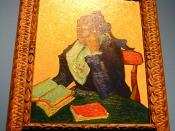Modernism is the movement which developed out of the French impressionism under the influence of Cezanne, Seurat, Van Gogh, Gauguin, Matisse and the artists associated with their respective circles. Artists no longer sought to imitate nature-an ideal the nineteenth century had cherished. Some supporters of the modern movement maintain that the avant-garde artists in the early twentieth century gave up attempting to imitate nature because that was a simple matter having little to do with art. Today we know that such arguments are naïve and indeed untrue. The impressionists did not break with nature because its imitation was easy or irrelevant to good painting. They gave up because they came to realize that it is not possible to separate entirely what we see from what we know and what we feel.
All art, even the most naturalistic, is to some extent conceptual. The artists of the modern movement became increasingly aware of this.
They also placed a greater emphasis upon the expression of the artist's personality in his work. Paintings were to express the artist's mood and feelings. They also placed great emphasis upon hues,especially the arrangement of line, color and mass in effective artistic structures. Tone, the handmaiden of illusion, fell into disrepute.
In Australia the influence of post-impressionism first appears in works of Sydney art students trained by Dattilo Rubbo(1870-1955). He studies at Rome and Naples before returning to Sydney in 1897. A year later, he opened an art school in Blighton and also became instructor in painting at the Royal Art society.
Rubbo was a colorful personality greatly loved by his students throught his own school which flourished for forty-three years, brought new interest in color to art teachings in Sydney. His own work devoted largely to portraiture and genre painting, much of it being strong in...


